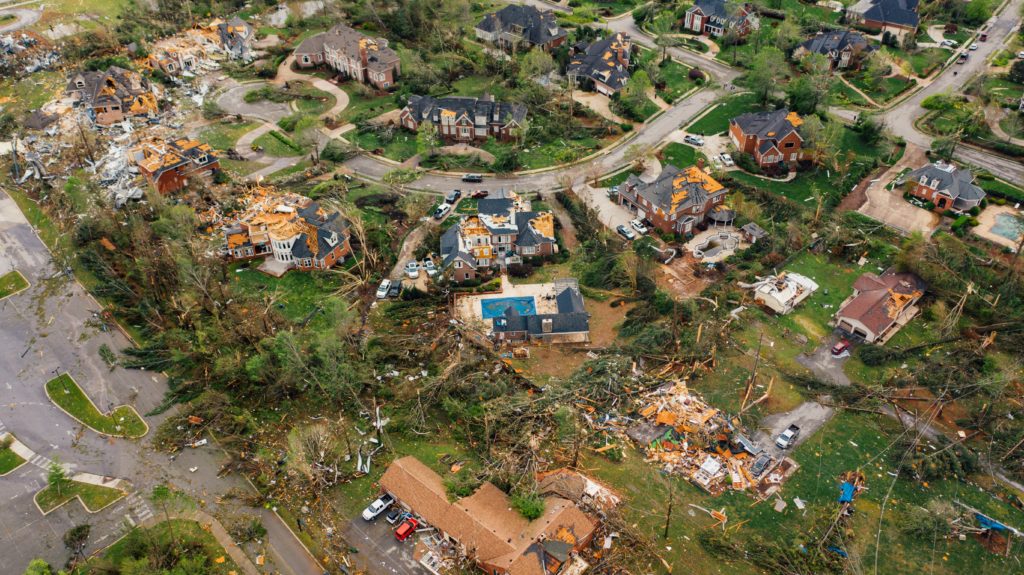Climate News Weekly Episode 123
October 30, 2023
Chevron acquires Hess, what happens to captured CO2 today, Hurricane Otis, and more
In this Episode
On today’s Climate News Weekly episode, James Lawler is joined by Dina Cappiello to discuss Chevron’s latest acquisition of Hess, what really happens when CO2 is captured in the US, the severe impacts of Hurricane Otis and what they mean, and more.
Related Media:


Climate Now: May 23, 2023
The evidence for peak fossil electricity
In 1909, headlines declared the U.S. would run out of petroleum by 1940. In 1945, the estimate was that the U.S. had 13 more years of petroleum reserves left. In 1966, we only had 10 more years before the “figurative dipstick in the United States’ oil sup


Climate Now: May 17, 2021
Social Cost of Carbon with Tamma Carleton
Hosts Katherine Gorman and James Lawler interview Dr. Tamma Carleton about how to determine the real cost of a ton of carbon and how that number can be used to create policies and regulations.


A Climate Change Primer Ep 4
Social Cost of Carbon
How are the benefits of new climate policies weighed against the costs of their implementation? Climate economists and scientists have created a value called the social cost of carbon in order to better understand the cost/benefit relationship of climate polic


Climate Now: Jun 1, 2021
Costs of Climate Change with Ian Bolliger
Dr. Ian Bolliger, Climate Data Scientist at Rhodium Group and affiliate of the Climate Impact Lab, joins Climate Now podcast hosts Katherine Gorman and James Lawler to explain how we measure the costs of climate change (in dollar terms) across sectors and comm


A Climate Change Primer Ep 3
Costs of Climate Change
It's hard to put a dollar number on the destruction of the great barrier reef. And we don't know exactly how much it's going to warm where. But we can take physical estimates and quantify the range of monetary impacts that climate change might cost. In this video, we examine the projected costs of climate change in human health, agriculture, sea level rise and extreme weather, labor and energy, and migration.


Climate Now: Jun 18, 2021
Carbon Capture 101 with Howard Herzog
According to the IPCC’s 2018 report, carbon capture and storage – in addition to a significant reduction in emissions – will be necessary in order to limit global warming to 1.5 degrees above pre-industrial levels. But what is carbon capture,
Episode Transcript
James Lawler: [00:00:00] Welcome to Climate News Weekly. I am here with the incomparable Dina Cappiello. Dina, welcome.
Dina Capiello: Thanks for having me!
James Lawler: So we want to start with yet another major acquisition by an oil and gas giant. Chevron’s acquisition of Hess for 53 billion in stock this past week. This follows on the heels of the Exxon acquisition of Pioneer. So Dina, there’ve been a number of stories about this. Can you update us on this most recent acquisition and what it means?
Dina Capiello: Obviously this raises a lot of concerns about what this means for climate and I just want to tell our listeners that if I think you want a great take on this, there’s a wonderful article that came out this week by Clifford Krauss, who covers the oil industry for the New York Times, about kind of what this means. Because, as we’ve seen these major mergers, right, in the oil and gas industry, we’ve also gotten a series of reports, one from the [00:01:00] IEA, The World Energy Outlook, which, which talked about how this transition now to clean energy is unstoppable, and I think it’s more complicated than just like big bad oil buys more oil, and it’s much more nuanced.
James Lawler: As you mentioned, Dina, article makes the point that the day after the Chevron acquisition was announced, the IEA, International Energy Agency, released a report that concludes that the demand for oil, gas, and other fossil fuels will peak by 2030. The agency’s executive director, Fatih Birol, says the transition to clean energy is happening worldwide and is unstoppable. On the flip side, you have Scott Sheffield, who is chief executive of Pioneer Natural Resources, which was acquired by Exxon for a whopping 60 billion, saying I personally disagree. The majors disagree, OPEC disagrees. Everybody that produces oil and gas disagrees. Who is going to replace jet fuel? Who is going to replace petrochemicals? What alternatives will replace [00:02:00] all that?
Dina Capiello: The kicker of the piece is a quote from, uh, Mark Brownstein, who is a senior vice president at EDF, Environmental Defense Fund. And he says, I look at this wave of mergers and acquisitions more as players in the industry trying to squeeze the last light. Out of the existing business model, then as, as, as part of a transition to the future, this is much, it is more about acquiring assets to continue to provide cashflow. And the other thing that this article, and I’m going to just like recommend it again, Clifford Krauss, New York Times, I’m not on their payroll, is it talks about how for the big oil producers, the Petro States, like Saudi Arabia, right, where they, where they can produce oil relatively cheaply.
It’s really about the cost of production as we get to this point where demand slackens and brings the price down.
James Lawler: Right.
Dina Capiello: That cost of production is going to be absolutely key, but [00:03:00] in the big major integrated oil companies, they’re consolidating really to kind of compete with those petrostates, which already have a low cost of operation.
James Lawler: Yeah. So the article highlights this, you know, in a very stark disconnect between the two sides. One person who is quoted in the article is Daniel Yergin, who is the author of the amazing book, The Prize. And he’s quoted in the article. as follows. “Consolidation at this point is about giving the companies the scale to be more resilient to meet the various priorities at the same time.”
On the one hand, you have an administration asking them to increase production and on the other hand, you have the energy transition, you know, to sort of summarize that view, these acquisitions are defensive measures, you know, acquiring assets that have inexpensive production ready access to shore up their businesses.
Dina Capiello: I think James, it, this is- might be – like a good segue to the post piece that we also saw this week, because it deals with the oil industry. [00:04:00] There was a piece by Shannon Osaka of the Washington Post talking about carbon capture and, you know, how much of that is going on and what she talks about is that companies in the U.S. currently are capturing about 18 million metric tons of carbon dioxide from natural gas processing plants, oil refineries, power plants, and if that actually did indeed go underground and was buried somewhere forever, that would be basically the equivalent to taking about, you know, 4 million cars off the road every year.
But what really is happening is that 60% of that captured carbon dioxide is being used in, in what’s called tertiary recovery or enhanced oil recovery. So it’s being used to extract more oil underground.
James Lawler: So we’ve been doing enhanced oil recovery for a long time, like for many years, and that’s using [00:05:00] CO2, pumping it underground, which helps to produce the oil, right.
Now, under the IRA, there’s a tax credit 45Q that’s been in effect since 2008. Essentially, the credit rewards the geologic storage or the pumping of CO2 underground. Now, if you pump the CO2 underground and you use it for EOR, or as Dina, as you described it, for enhanced oil recovery, that is now worth under the IRA, uh, 60 dollars per ton.
If you get the CO2 from direct air capture, that is if you’re pulling it directly out of the atmosphere and not, you know, capturing it off of some process or something else, you actually get 130 per ton of CO2 that you store, if it’s used for EOR. Now, if it’s just stored permanently, not to produce additional oil, and you get it from direct air capture, you can actually claim 180 per ton for that geologically sequestered CO2.
So, you know, one of the [00:06:00] criticisms is that the bulk of the money… under that 45Q program does go to EOR because that’s where most of the carbon storage is happening, and I think that’s the point that, that this article is making. But the design, the structure of 45Q provision does reward more money if you’re using it to not do EOR, but rather to store CO2 permanently.
It’s just we only have two permitted class six wells in this entire country, which are the wells that are provisioned for permanent geologic storage, not for EOR.
Dina Capiello: Mmm-Hmm.
James Lawler: All right, so, in yet another large scale weather disaster, Hurricane Otis has killed at least 27 people in Acapulco, Mexico. Dina, what do you make of this story?
Dina Capiello: What I think happened, and we’ve seen this, you know, before with climate change, is that this got so strong, so quick, as it went over very warm surface waters, ocean that it took really [00:07:00] everybody by surprise in a new way. And I think that we’re just going to see more and more of that where the oceans are warming, thanks to climate change, that is really the fuel on the fire of a tropical storm of any type.
James Lawler: Right.
Dina Capiello: And unfortunately, like, the de facto assumption now has to be that, like, this is going to be worse than you think.
James Lawler: Yeah, what stands out to me about this story and other events that you’ve described, Dina, is it just is reinforcing this new understanding that our whole society, you know, the, the way we build buildings, where we’ve decided to live, the basic assumptions that we have, everything we sort of take for granted about like our environment is so dependent on these very small bands, these very small sort of intervals of a physical sort of reality.
So in this case, we’re talking about wind speeds. Like, with hurricanes, we expect the storm to be within a certain band and for it to intensify at a certain rate. That [00:08:00] expectation is no longer valid in so many of these cases. That’s the reality today, and that didn’t used to be the case, even just two years ago, three years ago.
For me, at least, you read that story, or any of these stories, and then you look at the 53 billion Chevron acquisition, these are nuanced pictures, but it’s just like, come on, can’t we, shouldn’t we be doing more?
Dina Capiello: Yup.
James Lawler: Right. I mean, how can we not be doing more? How can we not have, like, a price on carbon at this point, a tax on carbon? How can we not be accounting for the massive damage that emitting, you know, emitting CO2 and creating the warming that we’re creating is having? We’re seeing it everywhere. Why are we not pricing this to drive this transition faster? It’s crazy.
Dina Capiello: Yeah. Maybe everybody kind of has to adopt the Patagonia view of the world where the earth is your shareholder, right? And that’s like kind of what is needed.
James Lawler: Yeah. I think that’s right. I mean, and unfortunately, you know, we do live in this capitalist system where there’s supply and demand and [00:09:00] there’s the value that we’ve set on things. The value that we set on things is created in part by policies that we all decide to abide by.
One of which could very easily be a carbon tax that would accelerate the transition. How can we not be pricing the true cost of being reliant on fossil fuels, you know, from a policy standpoint?
James Lawler: Totally.
Okay. Thanks so much for listening. And thanks again, Dina, for joining.
Dina Capiello: Yeah. See y’all next time.
James Lawler: That’s it for this week’s episode of Climate News Weekly.
We hope you’ll join us next week. Climate Now is made possible in part by our science partners like the Livermore Lab Foundation. The Livermore Lab Foundation supports climate research and carbon cleanup initiatives at the Lawrence Livermore National Lab, which is a Department of Energy Applied Science and Research facility. More information on the Foundation’s climate work can be found at livermorelabfoundation.org.